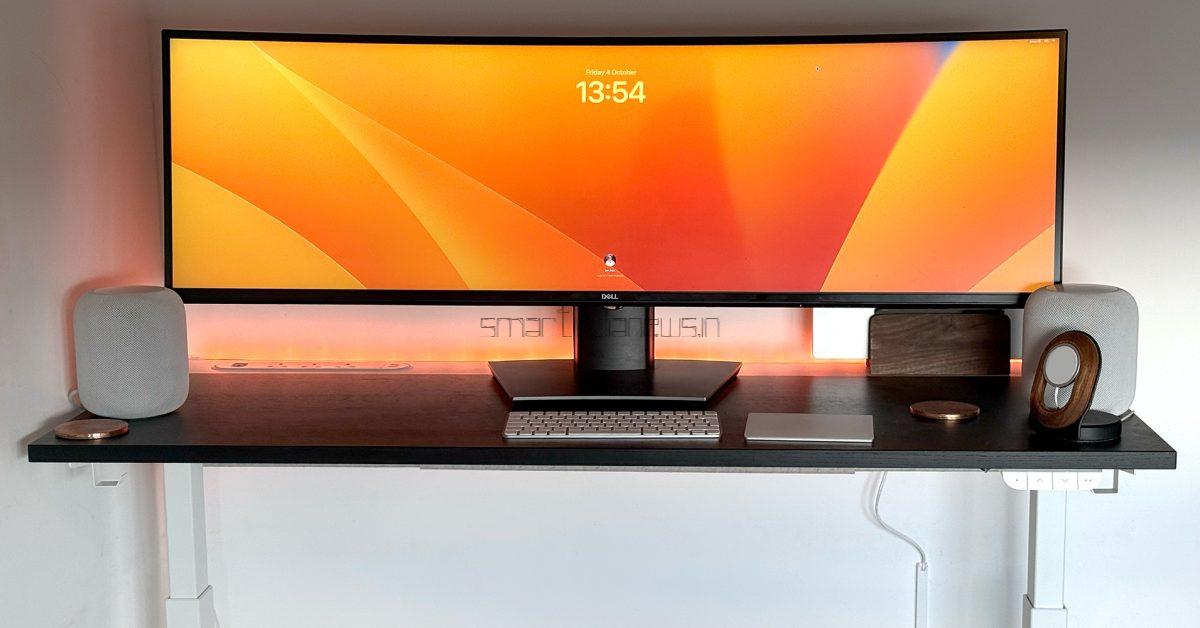I’m truly running behind on the sit-stand desk get-together. I’m aware. Jeff Benjamin, my coworker, was among the earliest to swap over in 2016, and even Apple made the transition mandatory for all its staff at Apple Park in 2018.
Up until now, I had been using a big, specially designed desk, but for the past couple of reasons, it appears to be an opportune moment to switch things up.
Initially, I’m planning to relocate to a new residence soon, which will be closer but will unfortunately mean a reduction in space, necessitating a desk that’s somewhat smaller than the standard ones in most places.
Secondly, the size of my desk allowed me to store more items. It’s a common saying that spending increases to balance out earnings, and my desk perfectly exemplifies this: its grand size enabled me to hoard numerous items on it and beneath it, and I did exactly that. External drives, scanners, two Mac computers, a microphone, and a joystick.
The scanner has been overtaken by an iOS app, and much of the remaining equipment is only utilized sporadically, so it was logical to store it in a drawer when not in use.
Indeed, my 49-inch display now occupies almost the whole width of my desk, and I still own the excessive number of stereo-paired HomePods – although this might not be the case forever – but the rest of my equipment has been replaced.
Since there are now less items that are always linked, this also meant that the Brydge powered dock was no longer necessary, so I’ve replaced it with an easier and more attractive Grovemade laptop stand, which is placed behind the computer screen:
I could have simply placed the Mac flat on my desk beneath the monitor, but that option doesn’t use as much space. Additionally, I’ve discovered that a standing stand is more effective for cooling down during more intense tasks such as video editing.
I had been captivated by these for a while, but had questioned if the initial excitement might fade, leading me to abandon the motor unit collection.
Nonetheless, I interviewed coworkers who own them, and it was evident that most had a definitive consensus that indeed, several months later, they continue to frequently alternate between sitting and standing positions.
My specific option ended up being quite narrow, as I aimed to keep its dimensions to 140cm across and 60cm down (55 inches by 24 inches). The justification for this restriction becomes apparent once I set it up in its new location and demonstrate it there.
This decision led to me purchasing the Ikea Mittzon. My perspective on Ikea furniture is that it combines subpar ‘wood’ (made from particle board with a thin layer of wood) with outstanding parts that undergo rigorous testing. I anticipate that I’ll eventually switch out the desktop for a genuine wood desk later on, but for now, the black ash wood veneer is satisfactory, and I have complete confidence in the durability of the mechanism.
This features an easy-to-use control board with two storage spots, along with buttons for adjusting in-person.
The way the cables were organized looked rather basic, leading me to think I’d probably need to get a new one. It’s an easy-to-use box with three separate sections that fold. Yet, it fits just right for two power strips and all my power bricks, and appears to be more sturdy than I anticipated, so I’ll keep it as long as it doesn’t break down later.
The last issue with organizing cables was dealing with those on the desk and power outlet plugs. It wasn’t possible to secure them, as they have to lengthen and shorten with the desk’s movement. I opted for a straightforward loop around a tube to achieve the cleanest appearance feasible.
I’ve been using this desk for almost a month now, and was pleasantly surprised in three aspects.
First off, I’m employing it frequently. I anticipated that I would recall to alternate between standing and sitting a few times a day, and spend 5-10 minutes on each. The truth is, though, that I alternate between sitting and standing every 30-40 minutes, and I spend as much time standing as I do sitting.
Moreover, the versatility comes in handy for activities beyond merely sitting or standing. For instance, my usual posture while sitting is with the chair at a low height and my feet planted on the ground. However, there are moments when I slightly elevate the chair and adjust the desk height as well. Furthermore, in my current living space, my desk is located adjacent to a countertop, and I’m considering adjusting the desk’s height to align with it when not in use, aiming for a more seamless appearance.
Third and most crucially, the desk has demonstrated incredibly effective relief for my back pain!
Having spent years of my professional life seated, even during those leisurely times during my days in the tech field, I’ve always endured (luckily not too severe) discomfort in my lower back. Yet, since making this new desk my regular setup, that has significantly lessened.
Now, I begin to experience minor discomfort after being in either a sitting or standing position for 30 to 40 minutes. This discomfort serves as a signal to switch positions, and the pain diminishes once I do. Simply do it again and again.
The concept that “sitting is the new cancer” has sparked a lot of debate, with the majority of experts calling it extreme exaggeration. Jeff concluded his article with this statement:
Standing or sitting for 8 continuous hours isn’t ideal, as neither option is healthy. The beauty of the PowerUp lies in its ability to change form swiftly, transforming from one state to another in just a matter of seconds.
In all circumstances, returning to a standard desk is out of the question for me. UpDesk has introduced an enjoyable new aspect to my daily schedule that could potentially increase my activity levels, for which I am thankful.
That’s precisely how I feel too. Making this office-related choice has been one of the finest decisions I’ve ever made, and I’m not looking to change it.
FTC: We use income earning auto affiliate links. More.

